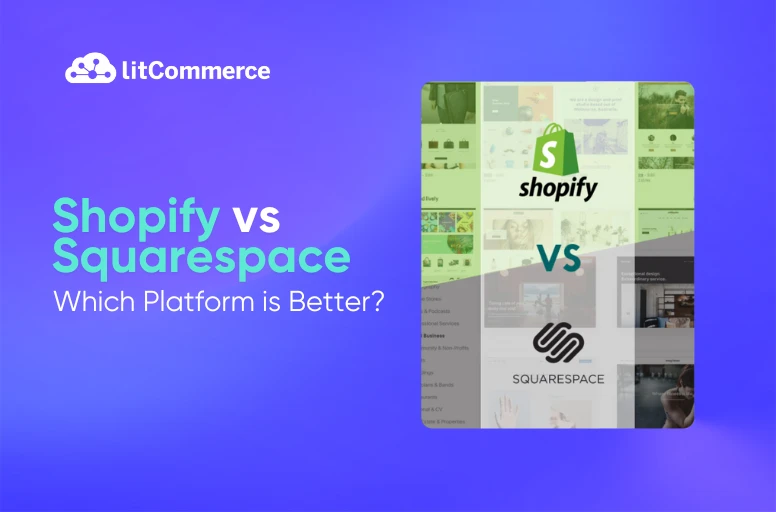Selecting the right platform for your website builder can be challenging. When considering Shopify vs Squarespace, the decision relies on your specific needs.
Shopify excels for serious, large-scale online stores, earning it the top spot as the best eCommerce builder. However, it may only suit some due to product types, budget constraints, or style preferences.
On the other hand, Squarespace, known for its all-around website-building capabilities, offers more affordable options with appealing designs. If you prioritize design and plan to sell a limited range of products, Squarespace might be your ideal choice.
Our thorough research and user testing reveal detailed insights to help you make your decision. We will compare Shopify vs Squarespace in terms of the following:
- 1. Target audience
- 2. Pricing
- 3. Ease of use
- 4. eCommerce features
- 5. Payment gateways
- 6. Design flexibility
- 7. Point of Sale (POS)
- 8. App integration
- 9. Marketing features
- 10. Customer support
Shopify vs Squarespace – 9 Key Differences to Consider Before Choosing
1. Target audience
When comparing Shopify vs Squarespace, it’s essential to look at who each platform serves best.
#Shopify
Shopify is a go-to platform for anyone looking to sell online, from small business owners to creative entrepreneurs. Let’s break down who Shopify is perfect for:
1. Small to medium-sized businesses (SMBs)
- Perfect for growing businesses: Shopify is super popular with small and medium businesses. Around 98% of its users fall into this group, many with teams of less than 50 people.
- Variety of industries: From fashion and electronics to beauty, food, and home goods, Shopify works well for all kinds of products. It’s a one-stop shop for businesses in any niche.
- Why they love it: It’s easy to use, affordable, and packed with tools that help businesses grow their online presence.
2. Entrepreneurs & creators
- Young and ambitious: Shopify is a favorite among young entrepreneurs, especially millennials and Gen Z. These folks love its simple design and tools that make starting a business a breeze.
- For the creator economy: Artists, influencers, and content creators flock to Shopify to turn their passions into income. Whether they’re selling art, handmade items, or branded merch, Shopify makes it easy for them to start and scale their stores.
3. Global users
- Reach beyond borders: While Shopify is super popular in North America (especially in the U.S. and Canada), it’s also growing fast in Europe, Asia, and Australia. Its ability to support multiple languages and currencies makes it a hit worldwide.
- For everyone, everywhere: Whether you’re selling locally or globally, Shopify’s features make it easy to connect with customers wherever they are.
4. Tech-Savvy Sellers
- Built for digital natives: Shopify is perfect for people comfortable with tech and digital tools. Its easy-to-use setup means you don’t need to be a tech wizard to get started.
- Room to customize: For those who love a bit of customization, Shopify offers tons of integrations and apps to tailor your store just the way you want.
#Squarespace
Squarespace is a popular website builder known for its sleek designs and easy-to-use features. Let’s take a closer look at the people who love and use it.
1. Creative professionals
- For the creatives: Photographers, designers, artists, and writers are big fans of Squarespace. They love it for its stunning templates that help showcase their work beautifully.
- Content creators: Whether you’re blogging, sharing videos, or selling products, Squarespace has tools for creators like influencers and small business owners to shine online.
2. Small business owners
- Perfect for small teams: About 66% of Squarespace users are small businesses with fewer than 50 employees. Many come from creative industries like food, art, and lifestyle.
- eCommerce made easy: Squarespace isn’t just for looking good—it’s got solid eCommerce features too. Small retailers love it for selling products while keeping their brand consistent.
3. Who’s using Squarespace?
- Young adults: The biggest group using Squarespace is aged 25-34. These are young professionals starting careers, running businesses, or side hustles.
- Balanced appeal: It’s a hit with both men and women, though slightly more women use it (52%).
Editor’s recommendations
Choose Shopify if:
- Your main goal is to sell products or services online and scale your store.
- You need robust eCommerce features like advanced inventory management, analytics, or integrations with other sales channels like Amazon or social media.
- You’re planning to run a medium or large online store with lots of products.
Choose Squarespace if:
- You want a visually stunning website to showcase your portfolio, blog, or brand with light eCommerce capabilities.
- You prioritize design flexibility and ease of use over advanced selling features.
- Your business focuses more on creative content or branding, with a smaller online store as an add-on.
2. Pricing
Both Shopify vs Squarespace offer different pricing structures to cater to a variety of businesses. Here’s how they stack up.
#Shopify
Plan | Monthly Cost (Annual Billing) | Notable Features |
Starter | $5 | - Sell on Facebook only |
Basic | $29 | - eCommerce features |
Shopify | $79 | - Advanced eCommerce features |
Advanced | $299 | - Comprehensive reporting tools |
Plus | Starts at $2,300 | - Custom solutions for large enterprises |
#Squarespace
Plan | Monthly Cost (Annual Billing) | Notable Features |
Personal | $16 | - Ideal for portfolios |
Business | $23 | - eCommerce capabilities (3% transaction fees) |
Commerce Basic | $28 | - No transaction fees on sales |
Commerce Advanced | $52 | - Advanced shipping tools |
Key takeaways:
For Shopify users:
- Business size and growth: New businesses may benefit from the Basic plan, while growing businesses might find the Shopify plan more suitable due to its advanced reporting and lower transaction fees.
- eCommerce focus: If selling primarily through social media or needing minimal features, the Starter plan is cost-effective. However, for comprehensive eCommerce needs, consider the Advanced or Plus plans.
- Transaction fees: Higher-tier plans reduce transaction fees, which can significantly impact profitability as sales volume increases.
For Squarespace users:
- Type of website: Creative professionals looking to showcase portfolios should consider the Personal plan. The Business plan is better suited for side hustles that require some eCommerce functionality.
- eCommerce needs: For those wanting to sell products online without transaction fees, the Commerce Basic or Commerce Advanced plans are ideal. The latter is recommended for larger stores requiring advanced shipping and subscription services.
- Budget considerations: Squarespace offers a free trial, allowing users to explore the platform before committing financially. Annual billing can also lead to significant savings compared to monthly payments.
3. Ease of use
In the debate of Shopify vs Squarespace, ease of use is crucial, particularly for those new to website building.
#Shopify
Shopify makes selling online simple and stress-free, even if you’re new to eCommerce. Its clean, easy-to-use dashboard ensures everything is within reach. On the left, you’ll find key features like products, orders, and analytics, while the right side is for making edits or adjustments.
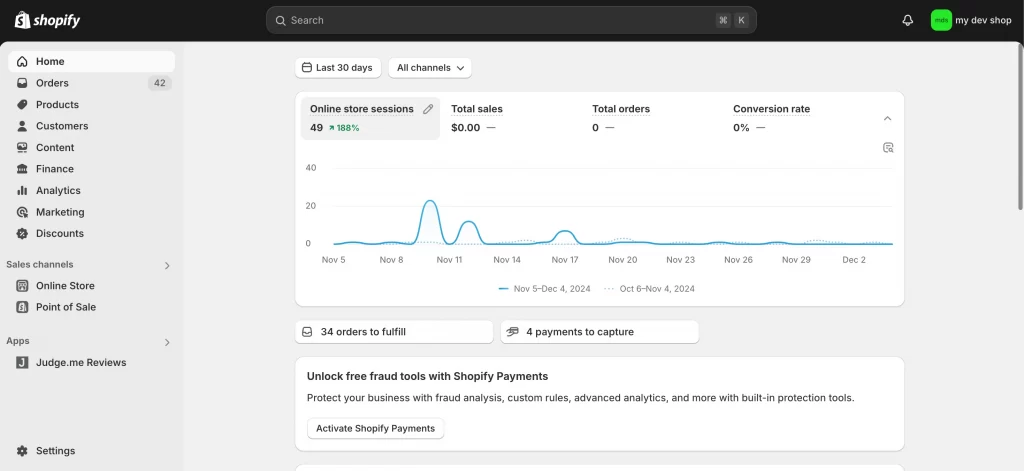
What’s more, Shopify saves you a lot of time with its smart tools. For example, its AI tool, Shopify Magic, helps you generate product descriptions or copy with just a few keywords or instructions. This feature is especially helpful when you need to list multiple items quickly.
Plus, Shopify allows you to upload or update products in bulk using CSV files, which makes managing large inventories faster and more efficient.
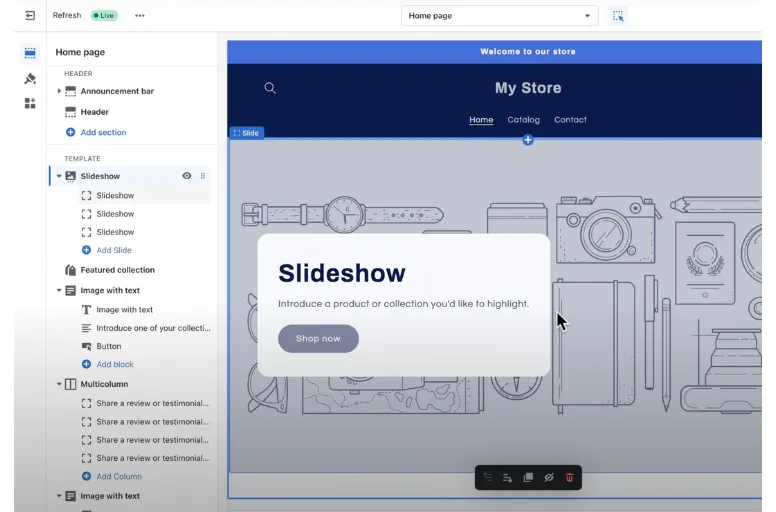
But the ease of use doesn’t stop there—Shopify’s product management tools truly stand out. The smart collection feature allows you to automatically group products into catalogs based on tags or keywords.
This means you won’t have to spend hours organizing your inventory manually. Additionally, adding product descriptions and images is straightforward, so your store looks polished and professional with minimal effort.
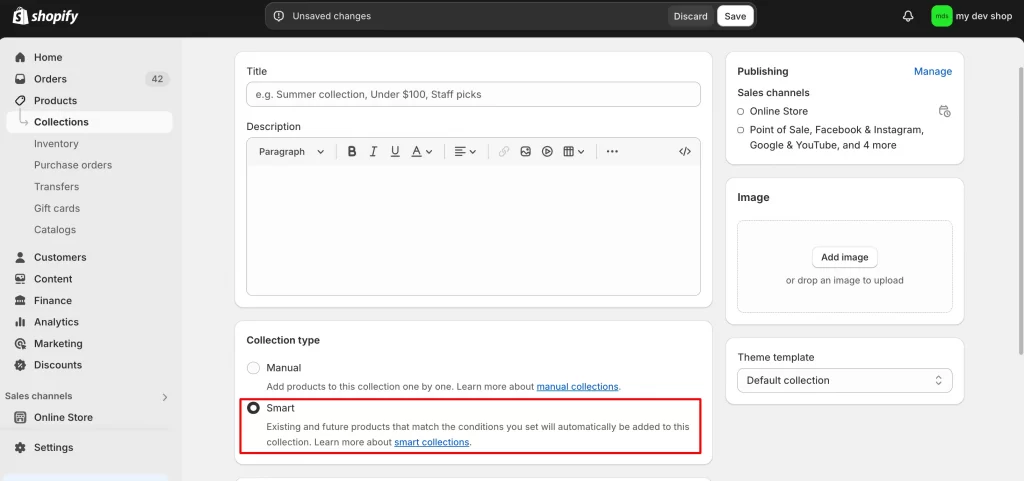
What makes Shopify even more appealing is how it handles large inventories, something many eCommerce platforms struggle with. For example, tools like smart collections are unique to Shopify and are rarely found in competitors like Squarespace or Wix. This gives Shopify a clear edge for sellers who need advanced features to keep their stores organized.
#Squarespace
Squarespace is known for its simplicity and elegance, making it a popular choice for building websites. Whether you’re setting up a site for the first time or managing an existing one, Squarespace offers a straightforward and intuitive experience.
Let’s take a look.
1. Easy setup process
Getting started with Squarespace is a breeze. The platform guides you through an easy-to-follow setup menu where you pick your template, name your site, and choose a category. Within minutes, you’ll have the basic framework of your website ready to go. It’s perfect for beginners who want a quick and stress-free start.
2. Building your website
When it comes to creating your website, Squarespace strikes a balance between simplicity and customization. While its grid system can feel a bit restrictive, it still provides plenty of options to personalize your site to match your style.

You can adjust layouts, colors, and fonts with ease, ensuring your website looks unique and professional without overwhelming you with too many choices.
3. Managing your website
Squarespace’s dashboard is one of its strongest features. Almost everything you need—editing content, managing pages, and adjusting settings—is conveniently located on the same page.
This streamlined approach makes it easy to keep track of your website and make updates without getting lost in a maze of menus. It’s a time-saver, especially for users who want everything in one place.
4. High-quality templates
Squarespace is well-known for its stunning templates. Each one is thoughtfully designed and serves a specific purpose, whether you’re showcasing a portfolio, running a blog, or starting an online store.
Unlike other website builders that mix good templates with mediocre ones, Squarespace keeps its quality consistently high, ensuring your site always looks polished.
Editor’s pick:
The winner depends on your specific needs.
- Shopify wins for eCommerce-focused users who need robust tools, scalability, and advanced features to manage and grow an online store effectively. It’s best for serious sellers and businesses with larger inventories.
- Squarespace wins for creatives and small businesses that prioritize aesthetics and simplicity. Its visually stunning templates and streamlined dashboard are perfect for showcasing portfolios or running a beautifully designed site with light eCommerce.
4. eCommerce features
The eCommerce capabilities of Shopify vs Squarespace can significantly impact your business operations.
#Shopify
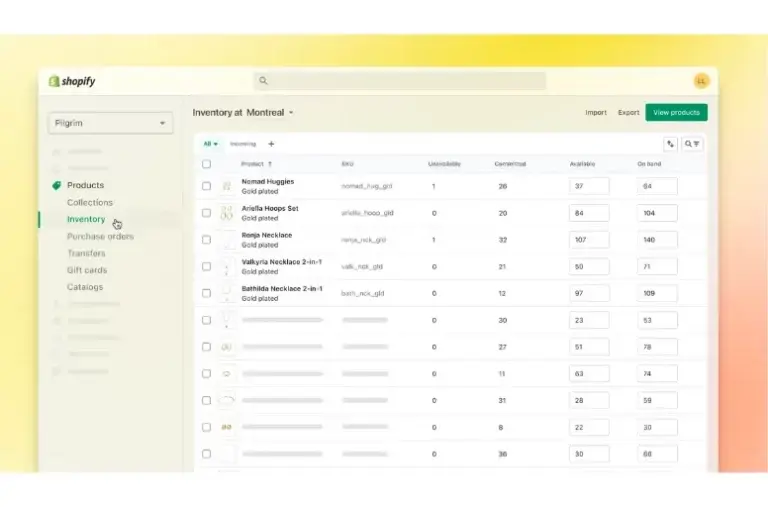
Shopify’s eCommerce features are extensive. It provides everything from inventory management to shipping integrations, product variants, and abandoned cart recovery. It allows you to sell across multiple channels, including Facebook, Instagram, and even physical stores through Shopify POS.
In details:
- Shopify makes setting up an online store quick and easy. Its customizable themes cater to a variety of industries, helping you create a store that aligns with your brand. Managing products is a breeze with features like unlimited product listings, variants, and collections. For businesses with large inventories, Shopify’s bulk import/export options save time and effort.
- Payment processing is another area where Shopify excels. The platform supports multiple payment gateways, including PayPal, Stripe, and Apple Pay, and allows transactions in various currencies. To optimize conversions, Shopify offers a fast, customizable checkout process aimed at reducing cart abandonment.
- Shipping and fulfillment are simplified through integrations with major carriers like USPS, UPS, and DHL. Shopify provides real-time shipping rates and even supports dropshipping options, making it versatile for different business models. Inventory management is also robust, with advanced tracking features, low-stock alerts, and support for managing inventory across multiple locations.
- Marketing tools are built right into the platform, enabling you to handle SEO, email marketing integrations, and abandoned cart recovery with ease. Additionally, Shopify’s analytics dashboard provides comprehensive insights into sales trends, customer behavior, and product performance, helping you make data-driven decisions.
Other standout features include:
- Multichannel selling: Sell on platforms like Facebook, Instagram, Amazon, and Etsy seamlessly.
- Customer profiles: Allow customers to create accounts for personalized experiences and track their purchase history.
- Mobile app management: Manage your store on the go with a mobile app that syncs orders and inventory in real time.
- POS integration: Sync online and offline inventory with Shopify’s Point of Sale system for in-person sales.
#Squarespace
Squarespace combines simplicity and style to deliver a range of eCommerce features that cater to small businesses and creatives looking for a polished online presence. Here’s an overview of what Squarespace offers:
- Squarespace’s eCommerce tools revolve around its fully integrated shopping cart, which allows customers to browse and checkout seamlessly. Product management is straightforward, supporting both physical and digital products. You can customize product pages with variants and options to fit your business needs.
- For payment processing, Squarespace accepts Stripe, PayPal, Apple Pay, and credit cards. While the options are more limited compared to Shopify, they cover the essentials for most small businesses. The checkout process is streamlined, with a guest checkout feature that helps reduce cart abandonment and improves the customer experience.
- Shipping tools are basic but effective, connecting with third-party carriers to calculate shipping rates. Inventory management is simple, offering tracking capabilities to help you keep tabs on stock levels. Squarespace also makes it easy to run promotions with features like coupon codes, discounts, and free shipping options.
- Marketing and analytics are well-integrated into the platform. Built-in email marketing campaigns allow you to promote products without needing third-party tools. The analytics dashboard helps you track sales performance, conversion rates, and customer insights to improve your store’s success. For search engine visibility, Squarespace includes basic SEO tools like customizable URLs and meta tags.
Other key features include:
- Templates: Stunning, professional templates ensure your store looks visually appealing and aligns with your brand.
- Subscription services: Offer subscription-based products or services directly through Squarespace.
Editor’s pick:
Shopify takes the lead with its comprehensive eCommerce capabilities, ideal for businesses with larger product catalogs and global sales ambitions. However,
- Choose Shopify if you need a powerful, scalable platform for managing a full-fledged eCommerce business.
- Choose Squarespace if you want a visually appealing, easy-to-manage website with basic selling capabilities.
Let your specific business needs—whether they lean toward functionality or aesthetics—guide your decision.
5. Payment gateways
When looking at payment flexibility in Shopify vs Squarespace, the difference becomes clear.
#Shopify
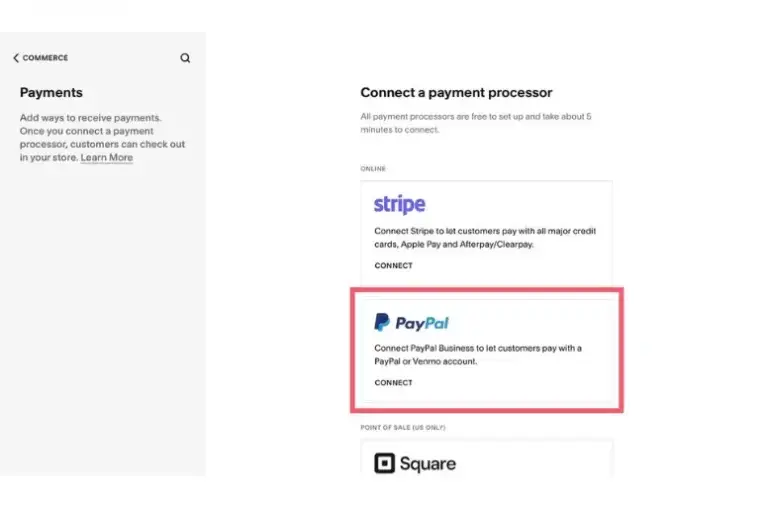
Shopify supports over 100 payment gateways, including PayPal, Stripe, and Authorize.net. The platform also offers its own gateway, Shopify Payments, which eliminates transaction fees for users who opt in. Shopify Payments provides seamless integration with reduced fees (as low as 2.4%) for larger plans.
Shopify payment gateway methods
Payment Gateway | Payment Gateway |
Shopify Payments | Native gateway supporting all major credit cards. Offers lower fees and fast payouts (within 3 days). |
PayPal | Automatically integrated, allowing payments via PayPal accounts. Transaction fees apply unless Shopify Payments is used. |
Stripe | Supports credit/debit cards, Apple Pay, and digital wallets directly on-site. No customer redirection. |
Amazon Pay | Leverages Amazon account trust for quick checkouts. |
Klarna & Afterpay | Allows customers to pay in installments while merchants get full payment upfront. |
Other Options | Supports additional gateways like Authorize.net, WorldPay, and regional options based on location. |
Payment features of Shopify
- Transaction fees: Shopify Payments eliminates extra transaction fees for third-party gateways, maximizing profits.
- Multi-currency support: Enables merchants to sell in multiple currencies, catering to global audiences.
- Shop pay: Accelerated checkout that saves customer details for quicker future purchases.
- Fraud analysis: Built-in tools to detect and mitigate fraudulent transactions.
- Mobile optimization: Ensures a seamless payment process on mobile devices.
#Squarespace
Squarespace is more limited in its payment gateway options, supporting only PayPal, Stripe, and Square. This limitation can be a drawback for businesses needing more flexibility or global reach.
Squarespace payment gateway methods
Payment Gateway | Payment Gateway |
Squarespace Payments | Built-in gateway supporting major credit cards and digital wallets. Limited to the US, UK, and Canada. |
Stripe | Primary processor supporting cards, Apple Pay, and Afterpay/Clearpay. |
PayPal | Enables payments via PayPal or Venmo accounts for ease of use. |
Square | Integrates with the Squarespace app for seamless online and offline sales. |
Afterpay & Clearpay | Supports buy-now-pay-later options for installment payments. |
Automated Clearing House | Direct bank transfers for US merchants. |
Payment features of Squarespace
- Integrated checkout experience: A streamlined, visually appealing checkout process.
- No transaction fees on Commerce Plans: Higher-tier plans (Commerce Basic and Advanced) eliminate transaction fees for Squarespace Payments.
- Flexible payment options: Supports credit cards, digital wallets (Apple Pay), and buy-now-pay-later services.
- PCI compliance: Ensures secure transactions with industry-standard compliance.
- Sales analytics: Provides insights into sales performance via an integrated analytics dashboard.
Editor’s pick:
When it comes to payment features and gateways, Shopify has a clear edge for eCommerce businesses that prioritize flexibility, scalability, and global reach. However, Squarespace holds its own for users who value simplicity and integrated solutions with fewer complexities.
Why Shopify wins:
- Extensive payment gateway options: Shopify supports a wide range of gateways, including regional ones, making it more versatile for international businesses.
- Shopify payments advantage: Eliminates transaction fees for users who rely solely on Shopify Payments, maximizing profits.
- Advanced eCommerce tools: Features like multi-currency support, Shop Pay for faster checkouts, and fraud analysis make Shopify better suited for large-scale eCommerce operations.
- Scalability: Its payment features are designed to grow with your business, accommodating both small startups and global enterprises.
6. Design flexibility
For creatives, design flexibility is crucial. Here’s how Shopify vs Squarespace compare.
#Shopify
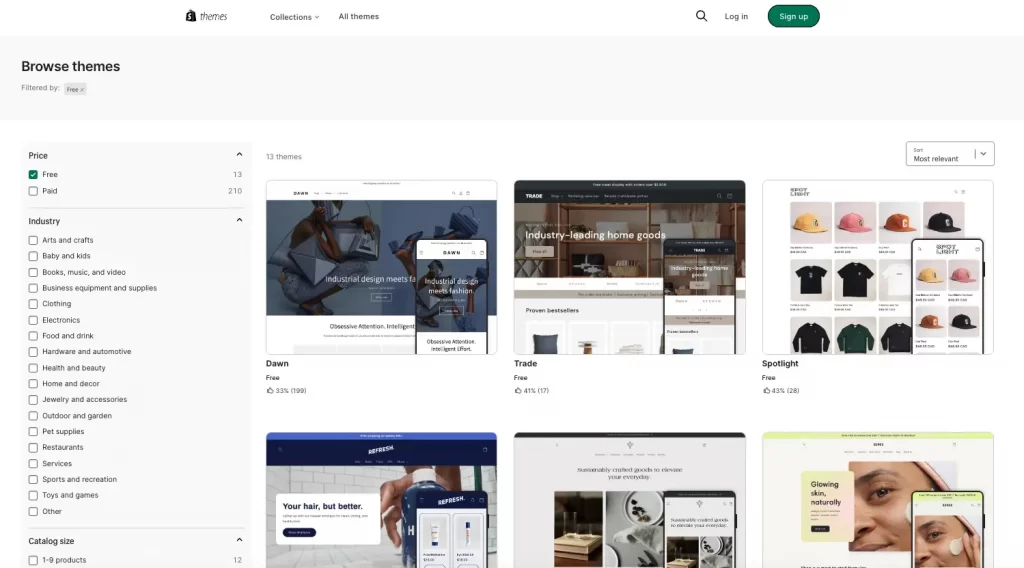
Shopify offers a wide range of design templates, with over 220 professional themes available, with only 13 available for free. Users can customize these templates to fit their brand’s identity using Shopify’s intuitive drag-and-drop editor.
If the limited free selection fails to meet your needs, there’s an alternative. Shopify allows users to explore premium themes priced between $140 and $500 each.

Note that: With Shopify, paid themes are a one-time purchase, so pick one that works for your budget and suits your needs. If you ever want to switch, it’s easy to do.
#Squarespace
Squarespace is a fantastic choice if you want a website that looks stunning and is easy to customize. With over 180 mobile-friendly templates, it’s perfect for creatives and businesses that care about great design. The templates are modern, professional, and work well on all devices.

While Shopify offers a wider variety of themes specifically designed for eCommerce, Squarespace presents only 7 themes tailored for online stores. However, any Squarespace theme can accommodate an online shop—whether designed for eCommerce or not; the functionality remains the same.
Using the Style Editor, you can tweak fonts, colors, and layouts to match your brand without needing to know any coding. Squarespace also includes built-in SEO tools to help your site get noticed online. And if you’re after something truly unique, you can explore premium templates from third-party creators.
Whether you’re building a blog, portfolio, or online store, Squarespace makes it simple to create a site that looks polished and professional. Its mix of great design and easy-to-use features means you can build a website you’re proud of without any hassle.
Editor’s recommendations:
- Squarespace: Best for visually stunning, customizable templates that are easy to use, ideal for creatives and businesses prioritizing design.
- Shopify: Great for eCommerce-focused themes with customization options, suitable for professional online stores with advanced functionality needs.
Choose Squarespace for design flexibility and aesthetics, and Shopify for robust eCommerce features and scalability.
7. Point of Sale (POS)
POS integration is another key difference between Shopify and Squarespace.
#Shopify
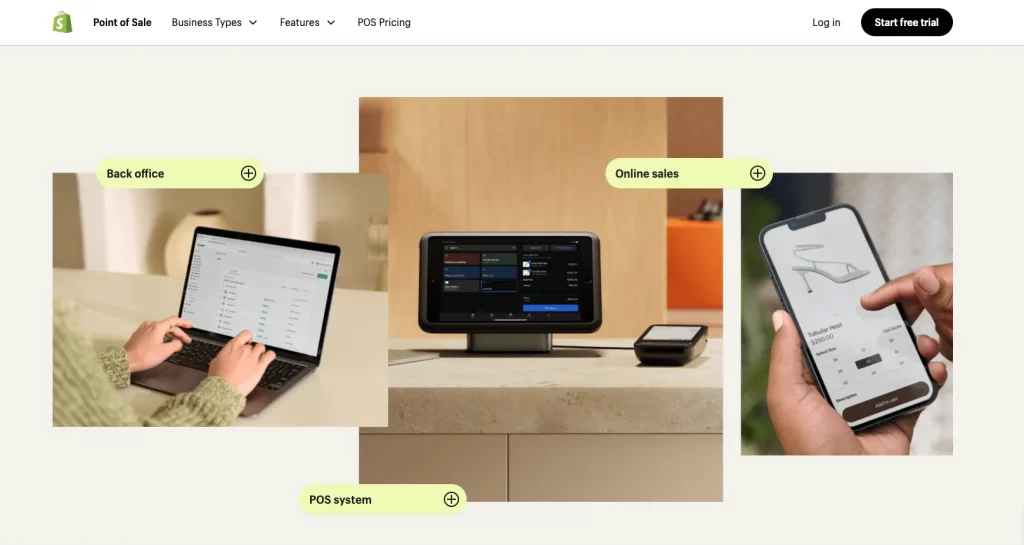
Shopify’s POS system has two pricing tiers: Shopify POS Lite and Shopify POS Pro. POS Lite is included with all Shopify plans at no extra cost, making it accessible for small businesses. However, the Pro version, which offers advanced features like multi-location management and in-depth analytics, costs an additional $89 per month per location.
When it comes to hardware, Shopify sells a range of devices like card readers, cash drawers, and receipt printers, which can be purchased separately. Shopify’s POS system is available globally, offering extensive support for businesses in multiple countries. Its mobile app lets you turn any iOS or Android device into a POS terminal, providing great flexibility and mobility.
#Squarespace
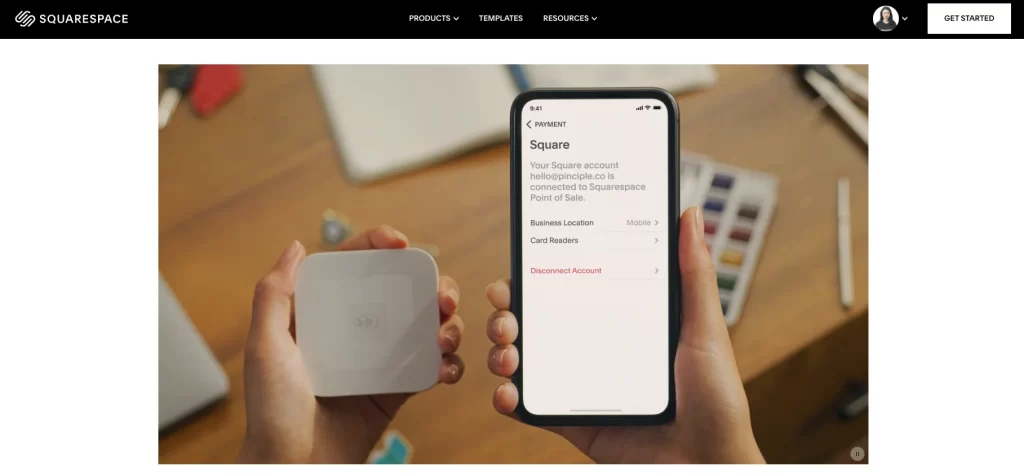
Squarespace POS is significantly more affordable but also more limited. The POS functionality is integrated with Squarespace’s Commerce plans, starting at $27 per month for the Basic Commerce plan, which includes online and in-person sales.
However, it offers a dedicated POS app for only IOS. It also relies on Square to process payments. This means you’ll need to purchase Square hardware separately, and transaction fees will apply depending on Square’s pricing structure.
Editor’s pick:
- If your business requires a robust, scalable POS system with advanced features and seamless integration between online and physical sales channels, Shopify is the preferable choice.
- However, if you operate a small business with basic in-person sales requirements and prefer a simple setup, Squarespace in conjunction with Square can suffice.
8. App integration
App integration is a significant advantage for Shopify vs Squarespace, especially for businesses looking to expand functionality.
#Shopify
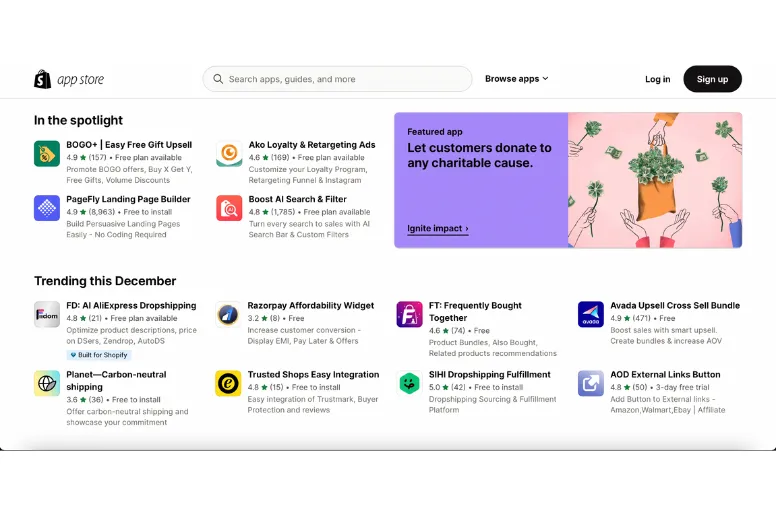
Shopify’s app ecosystem is vast, with over 8,000 apps available in its app store. These apps range from marketing, sales, shipping, customer service, and more, allowing merchants to customize their stores to meet specific needs.
Developers can also enhance Shopify’s functionality through app extensions, seamlessly integrating their tools into Shopify’s interface for a more tailored experience. Popular apps like MailChimp, QuickBooks, and Google Analytics integrate smoothly with Shopify. Now, over 87% of Shopify merchants use apps to extend their store’s capabilities.
Additionally, Shopify’s Point of Sale (POS) system supports UI extensions, enabling businesses to create customized workflows and integrate additional features directly into the POS interface, ensuring a seamless connection between online and offline operations.
#Squarespace
Squarespace’s app integration is more limited (nearly 40 apps in total), focusing on built-in tools to reduce dependency on external apps.
These extensions assist users in tasks such as selling products online, marketing their websites, and managing product feeds. To connect an extension, users can select “Connect to Site” and follow the prompts to integrate the tool into their Squarespace website.
It’s important to note that these extensions are developed by third-party providers, and while Squarespace vets them, support and maintenance are managed by the respective providers. Users should review each extension’s permissions and terms before integration to ensure alignment with their website’s needs.
Editor’s pick:
If your business requires extensive customization and a wide array of integrations, Shopify is the more suitable choice. However, if you prefer a simpler setup with essential integrations, Squarespace may meet your needs effectively. Your decision should align with your specific business requirements and technical capabilities.
9. Marketing features
When comparing marketing capabilities between Shopify vs Squarespace, each platform offers a unique set of tools to help businesses grow.
#Shopify
Shopify makes marketing simple and effective with built-in tools and apps from its extensive App Store. Here’s a quick rundown:
Built-in features:
- Shopify email: Create, automate, and send branded email campaigns with ease.
- Analytics: Track sales, customer behavior, and campaign performance to optimize strategies.
- SEO tools: Improve search rankings with customizable tags, meta descriptions, and sitemaps.
- Marketing automation: Automate tasks like cart recovery emails and customer segmentation.
- Social media integration: Sync with Facebook, Instagram, TikTok, and more for ads and shoppable posts.
- Google ads: Set up and run Smart Shopping campaigns directly from your store.
- Shopify collabs: Connect with influencers for brand promotion.
- Customer engagement: Use Shopify Inbox for live chat and lead capture forms.
Add-ons:
Apps like Klaviyo for advanced email marketing, Smile.io for loyalty programs, and tools for retargeting, pop-ups, and affiliate programs expand Shopify’s marketing power. It’s a great fit for growing businesses wanting to boost engagement and sales.
#Squarespace
Squarespace offers a range of marketing tools to help promote websites, engage customers, and boost sales. Here’s a breakdown:
Built-in tools:
- Email campaigns: Create branded emails with customizable templates, unlimited subscribers, and performance analytics.
- SEO tools: Optimize with custom title tags, meta descriptions, and automated sitemaps. Built-in analytics track search performance.
- Social media integration: Connect with platforms like Instagram and Facebook for social selling and automatic content sharing.
- Promotions & banners: Highlight sales or events with eye-catching website banners.
- Analytics dashboard: Track visitor behavior, sales trends, and traffic sources in one place.
- Contacts management: Organize audience details for targeted, personalized marketing.
Add-ons:
- Extensions marketplace: Find third-party tools like ShipBob for fulfillment or Hotjar for UX insights.
- Mailchimp integration: Advanced email marketing features like automation and detailed reports.
- Retargeting ads: Integrate with platforms to reach visitors who didn’t convert.
Editor’s pick:
- Shopify: Best for product-heavy businesses focused on scaling, with advanced tools like Shopify Email, SEO, and integrations for loyalty programs and retargeting.
- Squarespace: Ideal for small businesses or creatives needing simple, design-friendly marketing tools like email campaigns, banners, and social media integration.
Choose Shopify for advanced eCommerce marketing and growth, and Squarespace for straightforward tools paired with beautiful design.
10. Customer support
Lastly, customer support is a critical factor when choosing between Shopify vs Squarespace, particularly for businesses that need reliable assistance.
#Shopify
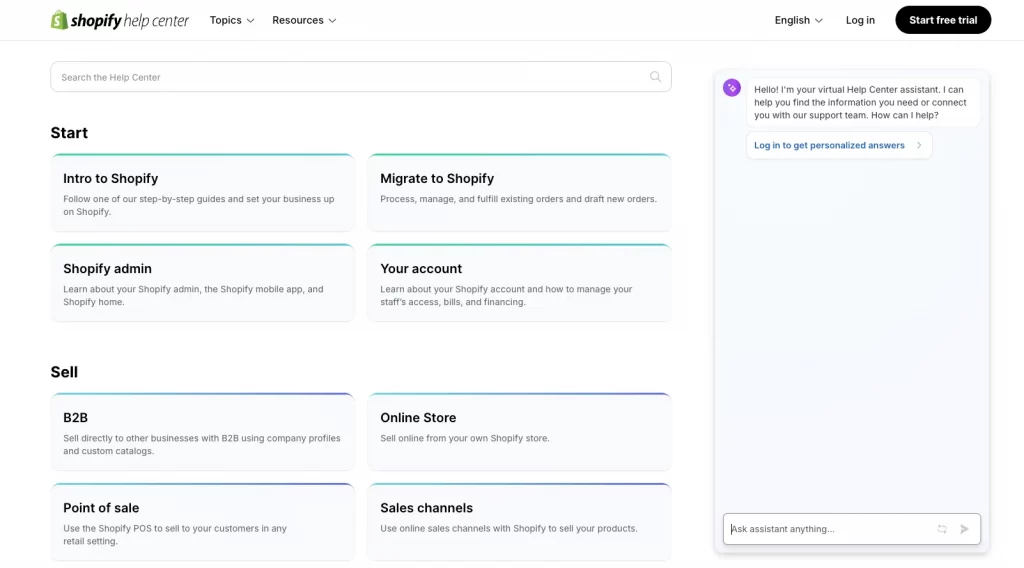
Shopify is known for its 24/7 customer support via live chat, email, and phone. The platform also has an extensive help center and a community forum for self-help. Shopify provides dedicated support through its Shopify Experts Program, making it ideal for businesses that require immediate and professional assistance.
Let’s get to know in detail:
Comprehensive knowledge base
- Extensive documentation: Shopify offers a well-organized knowledge base that covers a wide range of topics, including store setup, product management, payment processing, and order fulfillment. This extensive documentation allows users to find answers to common questions and issues independently.
- Step-by-step guides: The platform provides detailed step-by-step guides for various processes, such as migrating to Shopify or customizing the checkout experience. This user-friendly approach helps new users get started quickly and efficiently.
Diverse support topics
- Categorized information: The support content is categorized into clear sections, such as “Sell,” “Manage,” “Market,” and “Privacy and Security.” This organization makes it easier for users to navigate and locate specific information relevant to their needs.
- B2B and international sales tools: Shopify addresses the needs of different business models by including sections dedicated to B2B selling and international sales tools. This indicates an understanding of diverse user requirements and market dynamics.
Focus on security and compliance
- Privacy and security resources: Shopify provides information about privacy and security measures, which is crucial for users concerned about data protection. This transparency helps build trust with users regarding how their information is handled.
- Compliance guidance: The inclusion of compliance resources ensures that merchants are aware of the policies they must follow, which is essential for maintaining operational integrity.
Support for multiple sales channels
- Integration with various platforms: Shopify’s support includes guidance on using multiple sales channels, such as online stores, point-of-sale systems, and social media platforms. This flexibility allows businesses to expand their reach effectively.
Real-time status updates
- Service disruptions notifications: The support page includes real-time information about service disruptions (e.g., API & Mobile issues), directing users to the Shopify Status page for updates. This proactive communication helps manage user expectations during outages or technical difficulties.
#Squarespace
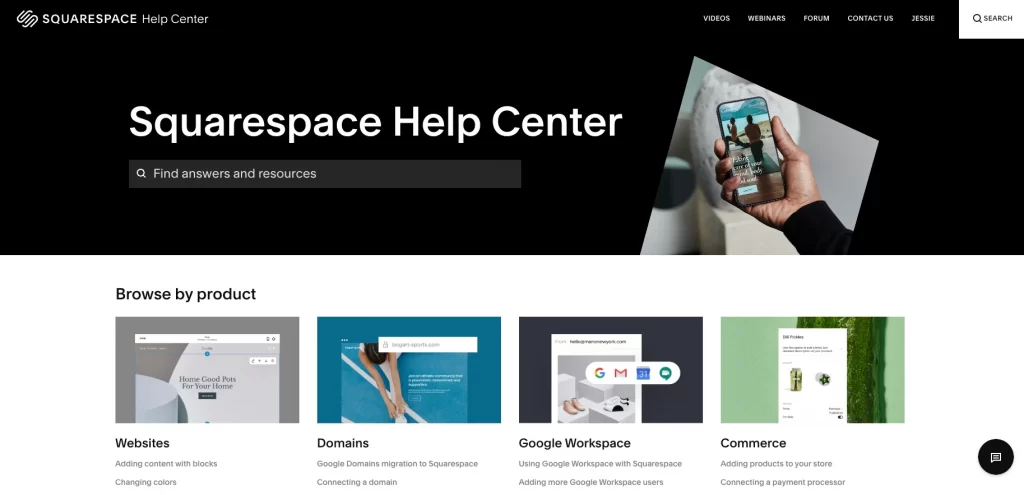
Squarespace offers a well-structured support system that balances user autonomy with necessary security measures, though it may require users to navigate some complexities in specific situations.
Comprehensive support resources
- Self-help articles: Squarespace offers a wide range of self-help articles and guides covering various topics, from account recovery to site management. This allows users to find solutions independently before needing direct assistance.
- Account recovery assistance: The support page emphasizes the importance of account recovery through the login page, providing clear instructions for users who may have trouble accessing their accounts. This proactive approach helps users resolve issues quickly.
Security and privacy measures
- Account holder verification: For security reasons, Squarespace only provides account details to the verified account holder. This policy ensures that sensitive information is protected, which is crucial for maintaining user trust.
- Document requirements for support: When recovering accounts or addressing certain issues, Squarespace requires users to submit specific documentation (e.g., government-issued ID and bank statements). This adds an extra layer of security but may also lengthen the support process for users.
Copyright and intellectual property support
- Copyright infringement process: Squarespace has a structured process for handling copyright infringement claims. Users can submit notices of infringement, and Squarespace responds by potentially removing or restricting access to allegedly infringing content. This demonstrates their commitment to respecting intellectual property rights.
- Clear communication: The support documentation outlines that in cases where Squarespace is merely the registrar (not hosting content), they direct users to resolve issues with the content owner or hosting provider. This transparency helps manage user expectations regarding the support they can provide in such scenarios.
Editor’s pick:
For businesses requiring round-the-clock support, Shopify provides more comprehensive and accessible customer service, making it the better choice.
Shopify vs Squarespace: Quick Assessment & Verdict
Shopify vs Squarespace, each platform caters to different user needs, and while both are powerful in their own right. Hence, understanding their strengths and weaknesses can help you make an informed decision. Below is a summary table highlighting the key comparison factors to give you a clearer picture of which platform might suit your business:
Factors | Shopify | Squarespace |
Target Audience | eCommerce-focused businesses, all sizes | Creatives, freelancers, small businesses |
Pricing | Starts at $39/month, transaction fees apply | Starts at $16/month, more affordable |
Ease of Use | Easy but can get complex with advanced features | Very intuitive, ideal for beginners |
eCommerce Features | Extensive, multi-channel selling, advanced tools | Basic, limited for large-scale operations |
Design Flexibility | 220 high quality and professional themes | Only 7 themes tailored for online stores |
POS | Advanced, syncs online and offline sales | Basic integration with Square |
App Integration | 8,000+ apps, highly scalable | Limited, focuses on built-in tools |
Marketing | Strong SEO, email, multi-channel marketing | Basic SEO, email, and social media tools |
Support | 24/7 support via chat, email, and phone | Email and chat, no 24/7 phone support |
In short, for scaling eCommerce operations with advanced tools and integration options, Shopify stands out. With features like multi-channel selling, abandoned cart recovery, and a robust POS system, Shopify is ideal for businesses focused on growth.
Squarespace is better for creatives, freelancers, and small businesses, prioritizing design and ease of use. It offers beautiful templates and a highly intuitive interface but lacks Shopify’s advanced eCommerce tools.
Squarespace vs Shopify: FAQs
Shopify is designed primarily for eCommerce, offering advanced selling tools, multi-channel support, and a vast app ecosystem. Squarespace focuses on visually appealing websites with basic eCommerce functionality, making it ideal for creatives or small businesses prioritizing design over complex sales features. If you’re expanding your eCommerce operations and need advanced features like inventory management, multi-channel sales, or a robust POS system, switching to Shopify makes sense. However, if your business mainly focuses on content and design with light selling needs, Squarespace might still be sufficient. For businesses with smaller product catalogs or light eCommerce needs, it’s worth selling on Squarespace. Its easy-to-use platform and beautiful templates make it ideal for those who prioritize design, though it lacks the advanced eCommerce tools found in platforms like Shopify. Squarespace is good for small online shops with simple product offerings. It offers basic eCommerce features, including inventory management and payment processing, but may not be the best option for larger businesses or those needing advanced sales tools and multi-channel integration.
Squarespace vs. Shopify: What is your choice?
In short, when it comes to eCommerce, both Shopify and Squarespace stand out as excellent website builders. Shopify excels in sales tools, whereas Squarespace shines in blogging and showcasing captivating images. So, the choice between “Shopify vs Squarespace: Which is better?” boils down to what you need and what you prefer.
If you’re considering Squarespace Shopify integration to make use of all their features, LitCommerce is an ideal partner. For further platform comparisons, explore our eCommerce blog or join our Facebook Community for valuable eCommerce insights and updates. Contact us anytime you need assistance!

